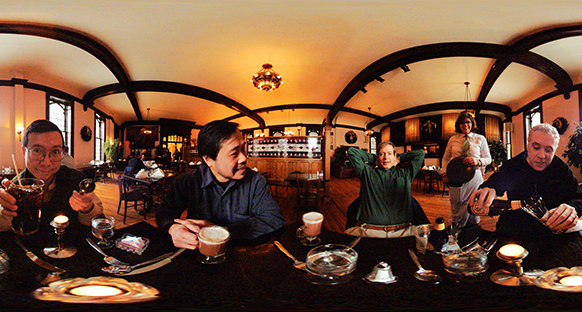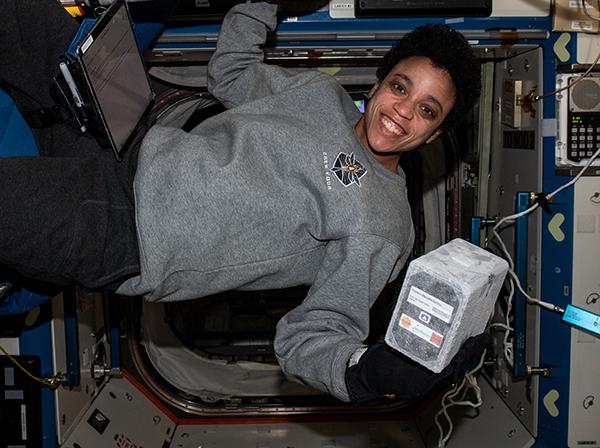
Immersive Photography Renders 360º Views
Originating Technology/NASA Contribution
NASA uses 3-D immersive photography and video for guiding space robots, in the space shuttle and International Space Station programs, cryogenic wind tunnels, and for remote docking of spacecraft. It allows researchers to view situations with the same spatial awareness they would have if they were present. With this type of photography, viewers virtually enter the panoramic image and can interact with the environment by panning, looking in different directions, and zooming in on anything in the 360-degree field of view that is of interest. As the perspective changes, the viewer feels as if he or she is actually looking around the scene, which enhances situational awareness and provides a high level of functionality for viewing, capturing, and analyzing visual data.
Partnership
A Small Business Innovation Research (SBIR) contract through Langley Research Center helped Interactive Pictures Corporation (IPC), of Knoxville, Tennessee, create an innovative imaging technology. This technology is a video imaging process that allows real-time control of live video data and can provide users with interactive, panoramic 360° views.
In 1993, the year that the first IPIX camera entered the market, it also received an “R&D 100” award, a prestigious honor given by R&D magazine for significant contributions to the scientific community.
The camera system can see in multiple directions, provide up to four simultaneous views, each with its own tilt, rotation, and magnification, yet it has no moving parts, is noiseless, and can respond faster than the human eye. In addition, it eliminates the distortion caused by a fisheye lens, and provides a clear, flat view of each perspective.
In 1995, an inventor named Ford Oxaal showed the company a technology he had developed which gives users the ability to combine two or more images, whether fisheye or rectilinear, into a single, navigable spherical image. Oxaal convinced IPIX to commercialize this useful showcasing technology, and combined with the advent of the World Wide Web, IPIX was able to execute a successful initial public offering.
The company has changed names at several points along the way. It started out as Telerobotics International, but changed its name to Omniview in 1995 after Oxaal showed his spherical media technology. In 1998, it became Interactive Pictures Corporation, and then later, Internet Pictures Corporation, and finally, IPIX Corporation. In 2007, Minds-Eye-View Inc., founded by Oxaal in 1989 and based in Cohoes, New York, purchased most of the operating assets of IPIX and is now in the process of taking the company and the technology to the entertainment industry. Oxaal is currently president and CEO.
Applications now include what Oxaal calls “homeland reconnaissance,” wherein critical infrastructure and public facilities are documented with spherical media; military reconnaissance; real estate and product showcasing; security and surveillance; and soon, interactive Webcasts.
Product Outcome
Through the NASA SBIR work, IPIX has created two 3-D immersive photography suites: a still image program and a video complement.
The IPIX package is a convenient and powerful documentation and site management tool. It is compatible with many off-the-shelf digital cameras and the final pictures are viewable in any immersive viewing formats, giving users a handful of benefits, including ease of use and the ability to capture and save an entire spherical environment with just two shots. The two images are fused together with no discernable seam, and the viewer can navigate throughout the picture from a fixed location. This is particularly helpful for virtual tours and has been widely embraced by the real estate, hotel, and automobile industries.
IPIX’s immersive video suite also offers many benefits. Users can count on immersive video to capture and save digital representations of entire environments, while providing multiple simultaneous views with a single camera and no moving parts. From within the immersive video view, users can electronically pan, tilt, and zoom, while the camera remains motionless. The system also provides wide, complete coverage, with no blind spots, and the files can be transmitted efficiently over networks, even over existing, commercial IP-based platforms.
Both of these camera systems can be employed in virtually any situation where immersive views are needed. They have been used in casinos, airports, rail systems, parking garages, schools, banks, stores, gas stations, automobile dealerships, amusement parks, hotels, homes for sale or rent, cruise ships, warehouses, power plants, incarceration facilities, theaters, stadiums, shopping centers, military facilities, government centers, assisted living centers, hospitals, gated communities, multi-tenant complexes, manufacturing plants, museums, hospitals, office buildings, colleges and universities, courts, and convention centers, to name just a few. Potential applications, however, are limitless.
In 2004, IPIX security cameras were chosen for surveillance of the 2004 Democratic National Convention in Boston and the 2004 Republican National Convention in New York. That same year, the technology was used for surveillance at the 30th G8 Summit at Sea Island, Georgia, and during the President’s second inaugural parade in Washington, DC. More recently, the technology has been used to secure everything from the CircusCircus Las Vegas Hotel and Casino to Meade High School at Fort George G. Meade, Maryland, to the Mt. Pleasant, Illinois, City Hall.
The technology isn’t only applicable to safety and surveillance uses, though. It is a popular complement to real estate and hotel Web sites, where visitors can take virtual tours of properties online.

Patented IPIX technology produces spherical images that let you feel like you are actually inside the scene. Image courtesy of Jook Leung.

With NASA assistance, IPIX developed the first commercially available immersive 360-degree photography, with widespread applicability in real estate and security markets. Image courtesy of Jook Leung.













